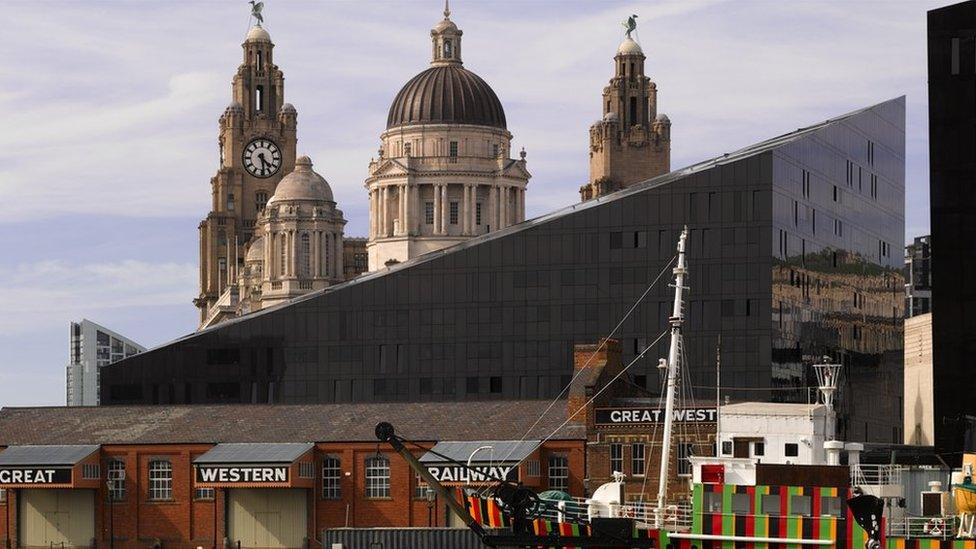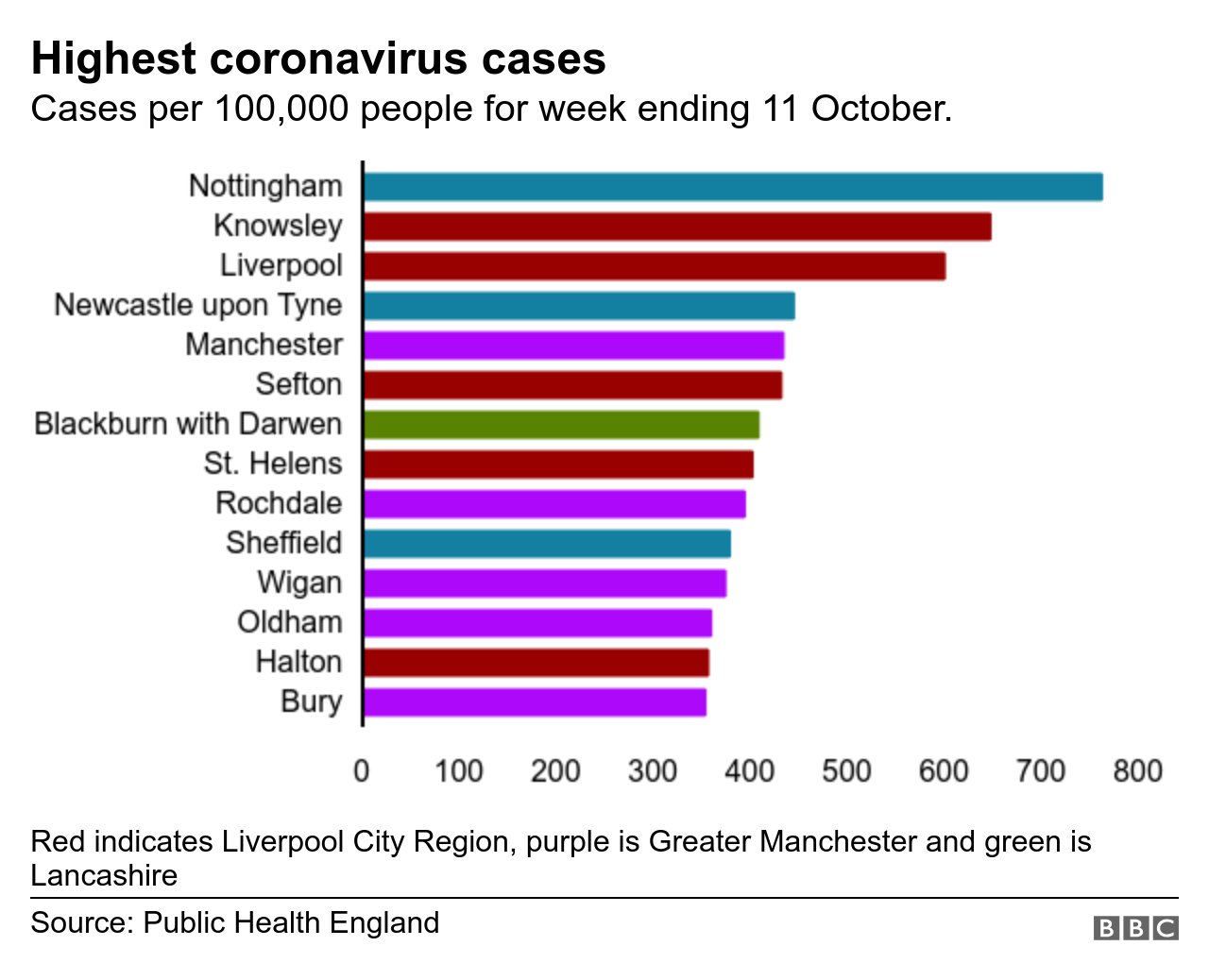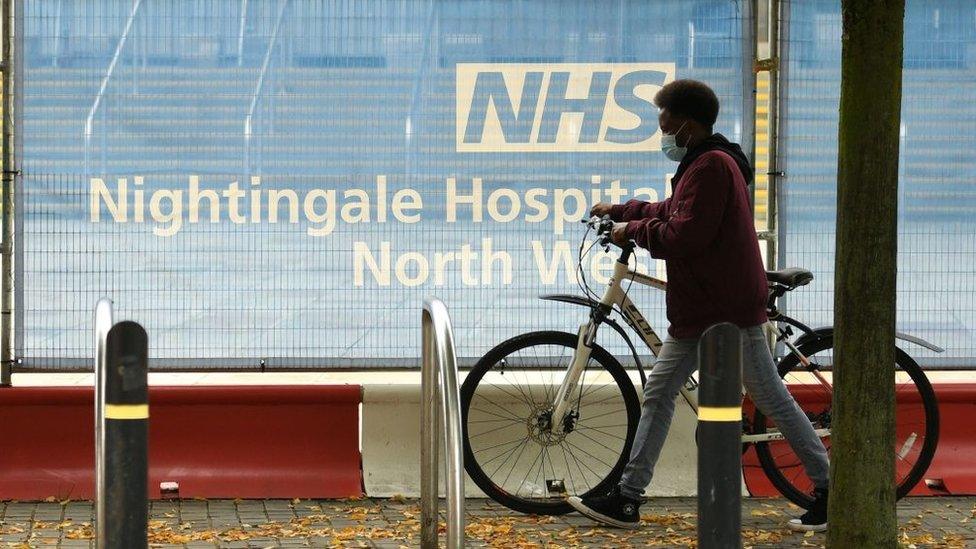Covid tiers: Why are some areas facing tougher restrictions?
- Published

New Covid-19 restrictions have come into force in the Liverpool City Region
New restrictions on daily life have come into force in parts of England deemed to be at the highest risk of coronavirus outbreaks.
They include curbs on meeting friends and family and going to the pub and are part of the government's new three-tier alert system.
Councils in England have been placed on "medium", "high" or "very high'' alert - with different levels of restrictions.
But questions remain over how these are decided and how councils can exit them.
1. Who goes in the highest tier and why?
Some areas with very high coronavirus rates are not on very high alert, while Liverpool and Lancashire are and - from Saturday - Greater Manchester and South Yorkshire.
In the week ending 11 October (the latest week for Public Health England data), Nottingham had by far the highest rates of coronavirus in England. Similarly, Newcastle upon Tyne ranked higher than many parts of the areas currently facing the toughest rules.

We asked the Department of Health to explain who goes in the top tier. It indicated that the reasons include:
Number and increase of coronavirus cases
The positivity rate (or the percentage of tests that come back positive)
Pressures on the NHS
Which age groups are being infected
Getting data on hospitals is difficult because NHS Trust areas do not directly overlap with local geography.
However, Liverpool's major hospitals saw 400 people either admitted with coronavirus - or diagnosed with it in hospital - in the week to 11 October. This is compared with 130 in the same period, in the previous month.
Greater Manchester and Lancashire have also seen high case rates (often ranking highly in Public Health England's weekly analysis) and have also seen noticeable spikes in hospital cases.
2. Why isn't Nottingham in the top tier?
We don't have access to all of the data public health officials use.
For example, we aren't given breakdowns of the positivity rates in local areas or what proportion of people catching the virus are young.
However, looking at highly localised case rates in England, the two worst "hotspots" (out of 7,200 areas in the country) were the University of Nottingham and Nottingham Trent University.
If students are driving up rates in some local authorities in a controlled setting such as a university campus, it might explain why a very high alert has not been introduced - as this age group is not considered high risk.
And if there is a hotspot in a local authority with an older population - as is being suggested in the case of Liverpool - this could lead public health officials to take stronger precautions.

Cases have been rising in Nottinghamshire's major hospitals as well, although at a slower rate than the North West regions.
3. How do councils get out of the top tier?
This hasn't been laid out.
The government says it will review very high risk areas every four weeks, but has not explained what would be deemed as suitable progress. It's likely it will look at some of the factors mentioned above.
It's worth pointing out that some areas which have previously gone into local lockdowns have seen them loosened once progress was made, including Luton, Leicester and Oadby and Wigston.
4. Why don't restaurants in the top tier have to close?
On 21 September, the government's scientific advisers called for the immediate temporary closure, external of all bars, restaurants and cafes. They noted that going to them was associated with ''increased risk'' and that outbreaks had been linked to these venues.
But hospitality venues in almost all parts of England have been allowed to stay open, subject to a 10pm curfew and other rules.
Even in places facing the tightest restrictions, restaurants can remain open. Pubs and bars can do the same if they serve "substantial meals", while alcohol can only be served alongside food.

We asked the government why such venues were exempt.
It said that although they were considered "higher risk environments than other indoor settings... by limiting the length of time customers spend in these venues, we are making them safer and reducing the risk of transmission".
It's a different story in central Scotland where most licensed premises - including pubs, bars and restaurants - have closed for at least two weeks as part of a ''circuit breaker'' attempt to reduce viral transmission.
5. Why is UK travel restricted but not some foreign travel?
People should avoid travelling in and out of areas under the highest alert level, other than for reasons like work or education, the government says.
It also advises residents under very high alert not to stay overnight in other areas.
But no extra restrictions on foreign travel from the affected areas have been applied.
At present, the government in England does not advise against non-essential journeys to countries on its ''travel corridor'' list.
So to fly to one of these destinations from Liverpool Airport - which is under the highest alert level - would not be going against government advice, but to go on holiday in the rest of the UK would.
We asked the government for the rationale behind this decision, but this has not yet been provided.
Reporting by Eleanor Lawrie, Ben Butcher and Oliver Barnes

THE R NUMBER: What it means and why it matters
SOCIAL DISTANCING: What are the rules now?
LOOK-UP TOOL: How many cases in your area?
SOCIAL LIFE: Is it safe to go to the pub?

